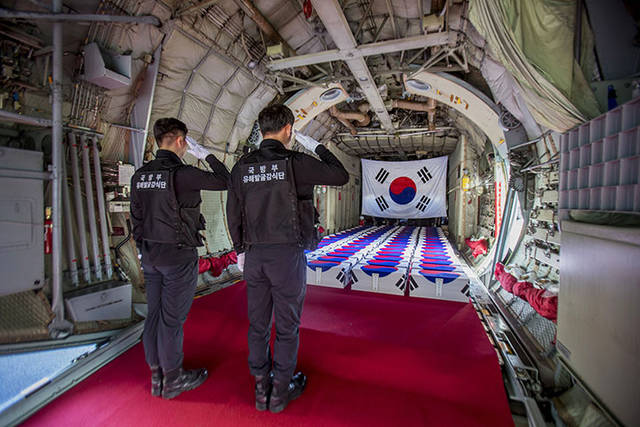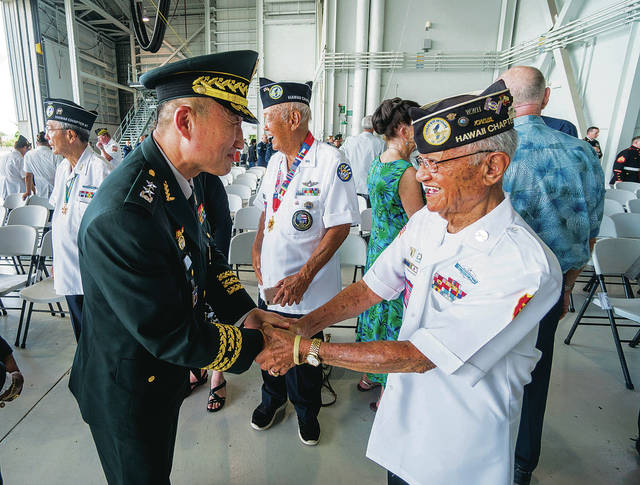Remains of 64 South Korean soldiers returned from Hickam


DENNIS ODA / DODA@STARADVERTISER.COM
The POW/MIA Accounting Agency and the Republic of Korea held a repatriation ceremony at Joint Base Pearl Harbor-Hickam on Thursday in honor of 64 fallen South Korean soldiers who fought during the Korean War. The 64 sets of remains were recovered in North Korea between 1996 and 2005.

DENNIS ODA / DODA@STARADVERTISER.COM
Maj.Gen. Sangbum Shin, left, shook hands with WWII and Korean War veteran Lucio Sanico.



The United States on Thursday returned the remains of 64 fallen South Korean soldiers to its ally in the largest such repatriation ever from the Hawaii-based lab that identifies missing service members from past wars.
Sixty-three flag-draped wooden boxes were placed in perfect rows on a Republic of Korea Air Force C-130 aircraft, and the 64th box was ceremoniously transferred from the Defense POW/MIA Accounting Agency to the United Nations to South Korea.
The blue UN covering was replaced with South Korea’s flag and South Korean Vice Minister of Defense Suh Choo-suk bowed to the unidentified casualty from the 1950-53 Korean War before it was carefully carried onto the green and gray camouflage cargo plane.
| PHOTO GALLERY: South Korean soldier repatriation held at Hickam Opens in a new tab |
“I am honored and humbled by the reason we are gathered here this morning for this repatriation ceremony — to pay our respects to the 64 fallen South Korean soldiers who today begin their journey back home,” said Rear Adm. Jon Kreitz, the accounting agency’s deputy director.
Two months ago, 55 sets of presumed American remains turned over by North Korea were received at the same hangar at Joint Base Pearl Harbor-Hickam. Two have been identified.
Don't miss out on what's happening!
Stay in touch with breaking news, as it happens, conveniently in your email inbox. It's FREE!
The remains that were returned to South Korea Thursday were part of recoveries made by the accounting agency in North Korea between 1996 and 2005 — when the missions were stopped as the result of North Korean nuclear provocations.
During 33 joint field activities into North Korea, the agency recovered more than 220 sets of remains. With the identifications being finalized for that group, 64 individuals were determined to be South Korean soldiers who fought alongside U.S. troops, officials said.
“We fought with them in Korea. In fact, in my company, there were several South Korean soldiers attached to us. We fought together. So it’s very important for me to be here to pay my respects,” Honolulu resident Stan Fujii, 88, who served in combat in North Korea in 1952, said after the ceremony.
Fujii was a 21-year-old machine gunner with the Army’s 3rd Division at the time.
“For a person from Hawaii (being in Korea) was quite dramatic — especially during the winter time when it snowed and was 30 below zero and we’re shivering all that time,” he said.
He faced both North Korean and Chinese People’s Volunteer Army forces, he said.
“The enemy is the enemy,” Fujii said. “Although I had no hard feelings toward the enemy, it was our duty to fight and kill them, like it was their duty to (try to) fight and kill me.”
About a dozen local Korean War veterans attended the ceremony in Hangar 19 along with a couple hundred U.S. and South Korean military members and officials.
“After 68 years, the fallen heroes are finally making their long-awaited trip back to their families,” Suh said during his remarks.
In July, one soldier’s remains were repatriated to South Korea. In 2016, 15 were returned, and in 2012 a dozen were returned, officials said.
Jennie Jin, the accounting agency’s Korean War project lead, said before the ceremony that the more than 220 sets of remains were recovered from mass graves and isolated burials in northeast and northwest North Korea from battles near the Chosin Reservoir and Unsan in late 1950.
The South Korean casualties were either Korean Augmentation to the U.S. Army, or KATUSA, soldiers, or Republic of Korea soldiers that fought alongside U.S. forces, Jin said.
DNA indicated the casualties were Asian, but the Hickam lab needed to make sure they weren’t Asian-Americans, she said.
“Then what we did was we looked at our Asian-American missing guys to see if they have (DNA) family reference samples, and fortunately, almost all of them who are still missing in North Korea, they have their family DNA on file,” Jin said. “So we did the matching and none of them matched these guys that we’re sending back to Korea today. So that was actually very strong evidence that these are not Asian-Americans.”
Recovery reports were then used to see, for example, if the Asians were buried with Americans, which was a good indicator that they were not enemy forces. “We never buried enemy forces with our guys,” Jin said.
Over the past month, scientists from the accounting agency and South Korea’s Ministry of National Defense for KIA Recovery and Identification, or MAKRI, were able to identify the remains as South Korean nationals, officials said.
“It is our fondest hope that the Republic of Korea will be successfully giving these heroes back their names,” Kreitz said.



